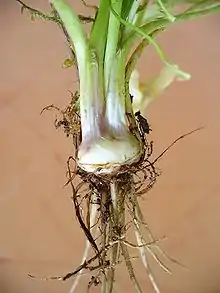Ranunculus bulbosus
Ranunculus bulbosus, commonly known as bulbous buttercup or St. Anthony's turnip,[1] is a perennial flowering plant in the buttercup family Ranunculaceae. It has bright yellow flowers, and deeply divided, three-lobed long-petioled basal leaves.
| Ranunculus bulbosus | |
|---|---|
 | |
| Scientific classification | |
| Kingdom: | Plantae |
| Clade: | Tracheophytes |
| Clade: | Angiosperms |
| Clade: | Eudicots |
| Order: | Ranunculales |
| Family: | Ranunculaceae |
| Genus: | Ranunculus |
| Species: | R. bulbosus |
| Binomial name | |
| Ranunculus bulbosus | |
Description

The stems are 20–40 cm tall, erect, branching, and slightly hairy, with a swollen corm-like base.[2]:120[3] There are alternate and sessile leaves on the stem. The flower forms at the apex of the stems, with 5–7 petals,[3] the sepals strongly reflexed.[2] The flowers are glossy yellow and 1.5–3 cm wide. The plant blooms from April to July.
Distribution
The native range of Ranunculus bulbosus is Western Europe between about 60°N and the Northern Mediterranean coast. It grows in both the eastern and western parts of North America as an introduced weed.[4] Bulbous buttercup grows in lawns, pastures and fields in general, preferring nutrient-poor, well-drained soils. Although it doesn't generally grow in proper crops or improved grassland, it is often found in hay fields[5] and in coastal grassland.
Etymology
The bulbous buttercup gets its name from its distinctive perennating organ, a bulb-like swollen underground stem or corm, which is situated just below the soil surface. After the plant dies in heat of summer, the corm survives underground through the winter.[6][7] Although the presence of a corm distinguishes Ranunculus bulbosus from some other species of buttercup such as Ranunculus acris, the species also has distinctive reflexed sepals.
Other names for the bulbous buttercup are "Goldcup" because of the colour and shape of the leaves, and "Frogs-foot" from their form.[8]
Chemical constituents
This plant, like other buttercups, contains the toxic glycoside ranunculin. It is avoided by livestock when fresh, but when the plant dries the toxin is lost, so hay containing the plant is safe for animal consumption.[3]
References
- "Ranunculus bulbosa". Natural Resources Conservation Service PLANTS Database. USDA. Retrieved 18 October 2015.
- Stace, C. A. (2019). New Flora of the British Isles (Fourth ed.). Middlewood Green, Suffolk, U.K.: C & M Floristics. ISBN 978-1-5272-2630-2.
- RH Uva, JC Neal and JM Ditomaso (1997) Weeds of The Northeast, Cornell University Press, Ithaca, NY. pp. 294-295
- Weed management
- Bulbous Buttercup: Ranunculus bulbosus
- S Coles (1973) Ranunculus bulbosus L in Europe. Watsonia 9: 207-228
- J Sarukhan (1974) Studies on plant demography: Ranunculus repens L., R. bulbosus L. and R. acris L.: II. Reproductive strategies and seed population dynamics. The Journal of Ecology: 151-177
- Grieve, Maud (1971). A Modern Herbal: The Medicinal, Culinary, Cosmetic and Economic Properties, Cultivation and Folk-lore of Herbs, Grasses, Fungi, Shrubs, & Trees with All Their Modern Scientific Uses, Volume 1. p. 149. ISBN 9780486227986.
External links
 Media related to Ranunculus bulbosus at Wikimedia Commons
Media related to Ranunculus bulbosus at Wikimedia Commons